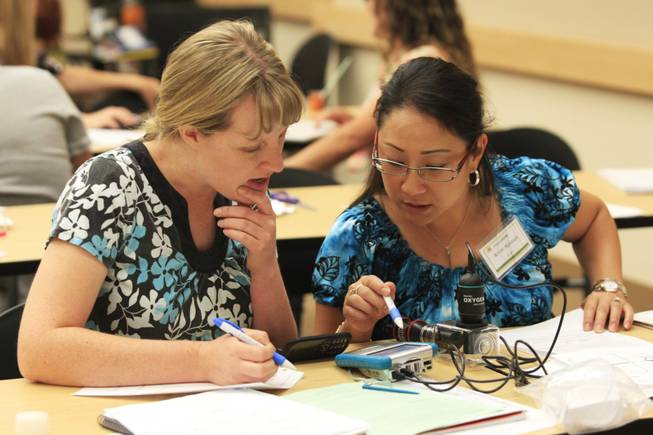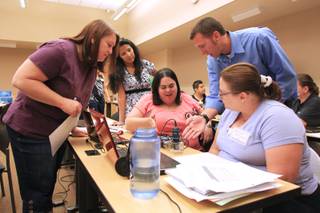
Clark County School District teachers Sarah Potts, left, and Kristi Raniada look at readings for an experiment during the Visions Summer Institute Wednesday, June 13, 2012 at UNLV.
Friday, June 15, 2012 | 2 a.m.
Sun coverage
While most Clark County School District teachers and students began summer vacation last week, a select group of 60 elementary teachers are extending their classroom work in a five-day program this week at UNLV.
“We’re suffocating crickets,” Christie Lebow, a gifted and talented education teacher and one of the participants in Project Visions, said with a laugh.
Project Visions, a partnership between UNLV’s Center for Math and Science Education and the district’s curriculum and professional development division, is a professional development program designed to boost student achievement in science. The program aims to improve teachers’ knowledge and understanding of concepts as well as help boost their self-confidence when it comes to teaching material in which they may not be experts.
The program is funded through a three-year grant by the Nevada Department of Education as part of a federal Math and Science Partnership program. This is the program’s third year.
“This year we actually had to turn people away,” said Eileen Gilligan, the district’s math and science curriculum coordinator for K-5. “We wanted to have the program give teachers a three-year experience, where they are building on concepts they learned last year.”
In fact, 47 of the 60 teachers participating this week are returning to the program for their third year.
Project Visions began Monday with teachers burning Cheez-Its.
“We wanted to show the metabolic process, and by burning the Cheez-It we were able to show what happens inside you at a much slower rate,” said Cindy Kern, a Visions teacher leader and Green Valley High School biology teacher.
Kern was the recipient of the Presidential Award for Excellence in Mathematics and Science Teaching in 2010. She began as a participant in Project Pass in 2005. It was the first project that hoped to bridge the gap between what is taught in high school science classes and what is taught at the college level.
Kern then went on to be one of two high school teacher leaders for Project Mist, similar to Project Pass but focusing on middle school teachers. Kern now has become an instrumental part of Project Visions and credits the program for allowing her to get her master’s degree and pursue her doctorate.
Teachers can receive a stipend upon completion of the program, which consists of 45 hours of schoolwork over five days. They also can earn credits toward graduate degrees.
Using concept maps, teachers can track their learning throughout the week in Project Visions.
“We are using analogies this year to really connect the big topics so that teachers see how these all go together,” said MaryKay Orgill, UNLV associate professor of chemistry.
Similar to using Cheez-Its to help illustrate a slowed metabolism, other analogies include activities that show teachers how inefficient the food chain is by giving them a cup with a hole in it. The teachers then have to get the cup to a bucket; the contents falling out of the hole shows them the amount of energy lost during the process.
Project coordinators made sure all of the labs and activities in place for the teachers can be reproduced in their classrooms. If there is a specific demonstration that uses materials they don’t have access to, like the machines used in the cricket lab (which measured cellular respiration), they are able to rent it from UNLV.
Project Visions shoots down the common perception that students and teachers live for summer vacation.
“We’re planners. We plan all summer for next school year,” said Terri Mann, a fourth-grade teacher at Ethel W. Staton Elementary participating in the program.
Project Visions not only helps teachers learn how to teach the content of its material to their students, it also gives them the opportunity to plan what they’re going to teach and how they’re going to teach it come fall.
“It gives us motivation for the next school year,” said Stacy Cohen, a first- through fifth-grade science teacher at Staton.
The program is in its final year due to the end of funding from the grant, but there will be Saturday workshops throughout the year to encourage teachers to better the way in which they relay curriculum to their students.


Join the Discussion:
Check this out for a full explanation of our conversion to the LiveFyre commenting system and instructions on how to sign up for an account.
Full comments policy